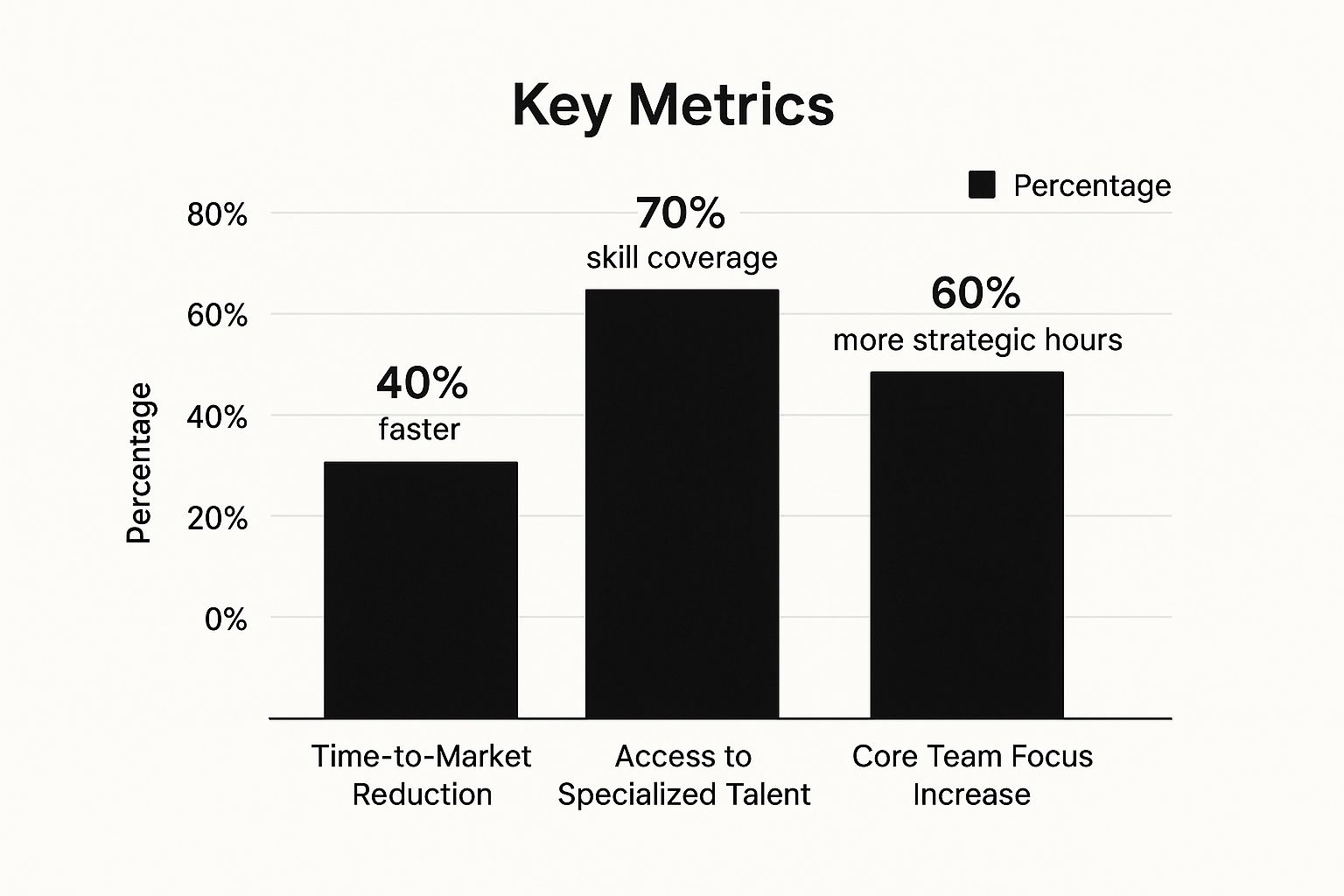A Guide to Outsourcing Software Product Development
Discover how outsourcing software product development can scale your business. Learn to find the right partner, manage projects, and achieve success.

When you decide to outsource software product development, you're essentially bringing in a specialized team to handle the technical heavy lifting for you. It's a lot like hiring a general contractor to build your house—you provide the vision and the blueprint, and they bring in the expert plumbers, electricians, and carpenters to make it a reality.
This strategy lets you tap into expert skills, get your product to market faster, and keep your own team focused on what they do best, all without the headache of building a new development team from the ground up.
What Is Outsourcing Software Product Development

Simply put, outsourcing software development means you partner with an outside company to design, build, and sometimes even maintain your digital product. This partner essentially becomes a seamless extension of your own company, handling anything from coding and design to testing and post-launch support. It’s a move that both nimble startups and established giants like Google and Amazon have used to their advantage.
It's about more than just handing off a to-do list; it's a strategic partnership. Your outsourcing partner dives deep into your project's goals, identifies any technology gaps you have, and assembles the right people to bring your idea to life. Whether you're building a simple mobile app or a sprawling enterprise platform, outsourcing can make the entire process far more efficient.
Key Outsourcing Models Explained
Getting the right fit starts with understanding the different ways you can partner up. The main models are all about geography, and each comes with its own set of pros and cons.
- Onshore: This means you're working with a company right in your own country. Communication is a breeze and there are no cultural hurdles, but it’s almost always the most expensive route.
- Nearshore: Here, you hire a team in a nearby country, usually one in a similar time zone. It’s a great middle ground that offers real cost savings while making it easy to hop on a call during your normal workday.
- Offshore: With this model, your team is in a country far away, often on the other side of the world. This is where you'll find the biggest cost reductions and access to a massive global talent pool.
Choosing the right model isn't just a logistical decision. It's about aligning your budget, timeline, and communication style to turn a simple vendor relationship into a powerful competitive edge.
What Parts of Development Can Be Outsourced
The short answer? Pretty much anything. The trick is to pinpoint where your in-house team is stretched thin—whether it’s a lack of specific skills, time, or people—and find a partner who can step in and fill that void perfectly. Knowing the full scope of available software product development services can help you zero in on what you truly need.
Some of the most commonly outsourced tasks include:
- Full-Cycle Product Engineering: Handing over the entire project, from the first sketch to the final launch and beyond, to a single, trusted partner.
- Complex Web and Mobile App Development: Bringing in specialists to build the kind of sophisticated, feature-rich apps your current team might not have the experience to tackle.
- Testing and Quality Assurance (QA): Making sure your product is polished, bug-free, and delivers a smooth user experience on every device.
- Cloud Infrastructure Management: Leaning on experts to build and manage a cloud setup that’s secure, scalable, and won't break the bank.
The Real Reasons Companies Outsource Software Development
For years, the conversation around outsourcing software development started and ended with one thing: cost. While saving money is still a nice perk, the game has completely changed. Today, the smartest companies outsource for reasons that are far more strategic and powerful.
It's no longer about cutting corners. It's about gaining a competitive edge. Think of it less as a budget-slashing tactic and more as a growth-hacking strategy. The goal now is to accelerate innovation, tap into specialized skills, and let your in-house team focus on what truly matters.
Access a Global Talent Pool
Picture your perfect software engineer. Maybe they're a wizard in a niche technology like blockchain or have a proven track record building HIPAA-compliant healthcare apps. What are the odds they live within commuting distance of your office? Pretty slim.
Outsourcing smashes through those geographical walls, giving you access to a worldwide pool of talent. A fintech startup in New York can instantly team up with top-tier blockchain experts in Eastern Europe. You're no longer limited to the developers you can find locally.
This hunt for specific skills has become the main reason companies look abroad. The shift is striking: while 70% of businesses said cost was their top reason for outsourcing in 2020, that number plummeted to just 34% by 2024. Today, 42% of companies outsource specifically to fill critical skills gaps. The data proves it: talent is the new king, not cost. You can dive deeper into this trend in the 2025 global outsourcing guide from Accelerance.
Accelerate Your Time to Market
In today's market, being first can be everything. Outsourcing lets you assemble a dedicated, experienced development team almost overnight, which can slash your time-to-market. Instead of getting bogged down in a months-long cycle of recruiting, interviewing, and onboarding, you can start building now.
A great partner comes with their own proven workflows, vetted engineers, and ready-to-go project managers. They can hit the ground running. This means you could launch your Minimum Viable Product (MVP) months ahead of competitors who are still trying to hire their first developer.
For many startups, this speed is the difference between capturing a market and watching someone else do it first. Outsourcing turns development from a potential bottleneck into a powerful accelerator.
This infographic breaks down just how much of an impact outsourcing can have on the metrics that matter.

As you can see, the benefits go far beyond just one area. Companies are launching faster, accessing better skills, and freeing up their internal teams to do more important work.
Empower Your Core Team to Innovate
Every hour your key people spend managing development logistics or recruiting engineers is an hour they aren't spending on big-picture strategy, talking to customers, or dreaming up the next big thing. Outsourcing the development work lifts that operational burden off their shoulders.
When you hand off the technical execution to a trusted partner, you free up your internal experts to focus on what they do best:
- Driving Business Strategy: Your leadership can zoom out and focus on market analysis, competitive positioning, and long-term growth.
- Deepening Customer Relationships: Your product and marketing folks can spend more time gathering user feedback and building a tribe of loyal fans.
- Exploring New Opportunities: Your team finally has the breathing room to research new features, explore adjacent markets, and innovate on your core product.
This isn't just delegation; it's a strategic move to ensure your most valuable resources—your people—are focused on high-impact work that moves the needle.
Where in the World Should You Outsource Your Software Development?

Deciding where to find your outsourcing software product development partner is so much more than just picking a spot on a map. The world is full of incredible tech hubs, and each one brings a totally different mix of talent, cost, and culture to the table. The right choice really comes down to what your project needs—your budget, your timeline, and just how complex the tech is.
This one decision can genuinely make or break your project. It’s not about hunting for the absolute lowest hourly rate. It’s about finding a strategic partner whose unique strengths are a perfect match for your business goals.
Let's take a quick trip around the world to look at the main outsourcing hotspots and see what makes each of them a solid contender.
Eastern Europe: A Powerhouse for Complex Engineering
Over the last decade, Eastern Europe has exploded onto the scene as the place to go for deep, serious technical talent. Countries like Poland, Ukraine, and Romania have a rock-solid focus on STEM education, which means they're constantly producing a stream of brilliant engineers.
This region is a beast when it comes to tricky projects involving AI, machine learning, and sophisticated backend systems. The developers here aren't just great coders; they're known for being fantastic problem-solvers who take real initiative. Plus, with excellent English skills and a culture that meshes well with Western Europe and North America, working together is usually a breeze.
When your project absolutely must have top-tier engineering talent and you can't risk cutting corners on quality, Eastern Europe is your best bet. Think of it as a strategic investment in technical brilliance.
The competition for outsourcing is really heating up. While Asia has traditionally dominated, Eastern Europe's growth is impossible to ignore. Countries like Poland, Ukraine, Romania, and Bulgaria now represent nearly 40% of the entire global outsourcing market. This boom is driven by their strong tech schools and the nearshore benefit for EU companies. For example, tiny Bulgaria has managed to grab an 8% global market share, which shows you just how much influence the region now has. For a deeper dive, you can check out the latest stats on the 2025 software outsourcing market share by country.
Latin America: The Nearshore Advantage
For any business based in North America, Latin America offers a killer combo of talent, value, and pure convenience. Places like Brazil, Argentina, and Colombia have booming tech scenes and an ever-growing pool of skilled software developers.
The biggest win here is time zone alignment. Being able to collaborate in real-time—without someone having to take a call at 3 a.m.—is a massive advantage for productivity and keeping the team connected. This makes Latin America a fantastic choice for any project using agile methods that rely on daily stand-ups and constant back-and-forth communication. On top of that, strong cultural similarities and familiarity with Western business practices make it easy to integrate them into your existing team.
Asia: Unbeatable Scale and Cost-Effectiveness
For a long time, Asia—especially countries like India and the Philippines—has been the heart of the global outsourcing world. This region gives you access to an unbelievably massive and diverse talent pool that can handle a project of just about any size you can imagine.
The main attraction for most companies is cost-effectiveness. The lower cost of living means firms in Asia can offer very competitive rates, making it a go-to for startups and businesses watching their budgets. This region is a particularly great fit for:
- Massive projects that need a whole army of developers.
- Work with a very clearly defined scope where budget is the top priority.
- Round-the-clock support and maintenance, since you can use the time difference to your advantage.
To help you visualize the differences, here's a quick breakdown of the top outsourcing regions.
Comparison of Top Software Outsourcing Regions
This table lays out the key differences between the major outsourcing hubs, looking at everything from hourly rates to cultural fit.
| Region | Key Countries | Average Hourly Rate (USD) | Top Technical Skills | Pros | Cons |
|---|---|---|---|---|---|
| Eastern Europe | Poland, Ukraine, Romania | $40 - $75 | AI/ML, FinTech, Complex Backend | High-quality engineering, Strong problem-solving skills, Good cultural alignment with the West | Higher rates than Asia, Potential political instability in some areas |
| Latin America | Brazil, Argentina, Colombia | $35 - $60 | Mobile Development, Web Apps, UI/UX | Time zone alignment with North America, Strong cultural affinity, Good value | Talent pool is growing but not as vast as Asia's, English proficiency can vary |
| Asia | India, Philippines, Vietnam | $20 - $45 | Enterprise Software, QA Testing, IT Support | Unmatched scale and cost savings, Huge talent pool, 24/7 productivity potential | Significant time zone and cultural differences, Communication can be a challenge |
Choosing the right region is the crucial first step. Once you understand the unique strengths of each global hub, you can find a partner who doesn't just build your product but actually helps drive your business forward.
How to Find Your Ideal Outsourcing Partner
Choosing a partner for your outsourcing software product development is easily the most important call you'll make. This isn't just about hiring a contractor; it's more like bringing on a co-founder for a huge part of your business.
Get it right, and you’ll have a seamless extension of your own team. Get it wrong, and you're looking at blown budgets, missed deadlines, and a product that just doesn't hit the mark.
The market for these services is absolutely massive. The global IT outsourcing market is expected to reach $731.2 billion by 2025, and software development is a giant piece of that pie. What’s driving this? Simple: companies everywhere need great developers, and outsourcing opens up a global talent pool.
This gives you a ton of options, but it also makes doing your homework more critical than ever.
Look Beyond the Portfolio
A slick portfolio is the bare minimum. Any agency worth its salt will have a gallery of beautiful, finished projects. Your job is to peel back the curtain and see what's really going on behind the scenes.
Don't just glance at the final product. Ask for detailed case studies. You want to hear about the tough problems they solved and how they did it. Even better, ask if you can see some anonymized code samples. You don't have to be a coding genius to get a feel for quality—even just checking for clear comments and a logical structure tells you a lot.
The goal isn't just to see what they built, but to understand how they build. A great partner can explain their development philosophy, their approach to code quality, and how they ensure the final product is maintainable and scalable.
This initial deep dive helps you quickly sort the agencies with real technical chops from the ones who just have a good marketing person.
Assess Their Project Management DNA
Technical skill is only half the battle. The other half is all about process. A team of brilliant but disorganized developers will give you more headaches than a well-organized team of solid engineers.
You need to know exactly how they’ll fit into your workflow. Get right to the point during your first conversations and ask direct questions:
- What tools do you live in? (Jira, Trello, Asana, etc.) Do they match up with what your team already uses?
- What does your communication rhythm look like? Daily stand-ups? Weekly reports? How do they handle those inevitable one-off questions?
- How do you handle scope creep? This one is a big deal. A professional team will have a clear, established process for managing changes to the project plan.
- Who is my go-to person? You need a dedicated project manager who will be your advocate and make sure nothing gets lost in translation.
Their answers will tell you if their team’s "DNA" is a match for yours. If you run a fast-paced agile shop that needs daily check-ins, a partner who only sends bi-weekly updates is going to be a terrible fit.
Look for a Partner, Not a Vendor
The best outsourcing arrangements feel like true partnerships. You want a team that's genuinely invested in your success, not just one that's waiting to cash your next check. This can be tricky to gauge, but there are definitely signs to watch for.
A real partner will push back and ask you tough questions. They'll challenge your assumptions and suggest better ways to get where you want to go. A vendor, on the other hand, will just nod and say "yes" to everything, even if they spot a potential disaster on the horizon. A good way to kick this off is by creating a thorough document of your needs. Our guide on writing an effective software development RFP can help you lay everything out clearly.
Finally, check out their team's stability. It's crucial to know how they find and keep their people; look for teams that are great at mastering full life cycle recruitment to ensure you're getting consistent quality. High employee turnover is a huge red flag—the last thing you want is to lose key developers halfway through the project. Ask about the average tenure of their team. A partner who invests in their own people is far more likely to invest in your product.
Best Practices for Managing a Global Development Team

So, you’ve picked the right partner for your outsourcing software product development. That’s a massive step, but let's be clear: it's just the beginning. The real work—the part that separates a good outcome from a great one—is all in how you manage that relationship day-to-day.
Think of it like conducting a world-class orchestra. You've hired incredible musicians from all over the globe. Now, you’ve got to hand them the sheet music, set the tempo, and make sure everyone is playing in perfect harmony. This isn't something you can just wing; it requires a thoughtful, structured approach.
Establish a Communication Rhythm
When your team is scattered across different continents, you can't just bump into each other in the hallway to solve a problem. You have to be deliberate. The key is to build a reliable communication rhythm that keeps everyone in sync, no matter the time zone.
This isn't just about scheduling meetings. It's about creating a framework for how, when, and where your team connects.
- Daily Stand-ups: These are non-negotiable. A quick daily check-in to cover progress, flag roadblocks, and set priorities is essential. Find a time that provides the most overlap for everyone.
- Weekly Syncs: Use a longer weekly call to zoom out. This is your time to review milestones, talk strategy, and tackle any bigger issues that have popped up.
- Asynchronous Tools: Lean heavily on tools like Slack, Jira, and Confluence. They ensure that crucial information is documented and accessible to everyone, regardless of when they're working.
For a more detailed look, our guide on building a project management communication plan template can help you lay this foundation.
Define a Crystal-Clear Project Scope
I can't say this enough: vague requirements are the number one killer of outsourced projects. Ambiguity is your enemy. It leads directly to rework, blown budgets, and missed deadlines. Before anyone writes a single line of code, you need a rock-solid project scope and a detailed Statement of Work (SOW).
This document becomes your project’s single source of truth. There should be zero room for interpretation.
- Project Goals: What problem are we solving? What does a "win" look like?
- Deliverables and Milestones: Break the entire project down into smaller, measurable pieces with firm deadlines.
- Technical Specs: Get specific about the tech stack, architecture, and performance standards you expect.
- Exclusions: Be just as clear about what is not included. This prevents scope creep and future arguments.
A well-defined scope is like a constitution for your project. It protects both you and your partner by setting clear boundaries and making sure everyone is working toward the exact same goal.
Foster a 'One Team' Culture
The best outsourcing relationships don’t feel outsourced at all. They feel like a true partnership. You have to actively break down that "us versus them" mentality and build a unified culture where everyone—internal and external—is pulling in the same direction.
Here’s how you can do that:
- Integrate the Teams: Invite your outsourced developers to company-wide meetings and add them to relevant social channels. Make them feel like part of the crew.
- Share the 'Why': Don't just hand off tasks. Explain the vision behind the project and how their specific work fits into the bigger picture.
- Recognize Their Work: When your external team members do great work, celebrate it. Give them public credit and acknowledge their contributions.
Of course, building a strong partnership also means being smart about security. It's crucial to get a handle on understanding third-party risk management to protect your intellectual property and ensure data security is airtight. Trust is built on both great culture and solid operational practices.
Your Software Outsourcing Questions, Answered
Jumping into software product development outsourcing for the first time? You've probably got a lot of questions. Getting straight answers is the first step toward making a great decision and finding a partner you can trust. Let's tackle the most common ones.
How Do I Make Sure the Quality Is Top-Notch?
Great quality isn't an accident; it's the result of a solid process. Don't just take a vendor's word for it. Dig into their technical skills and ask to see detailed case studies of work they're proud of. Before anyone writes a single line of code, you should work together on a rigorous Quality Assurance (QA) plan that includes things like regular code reviews and automated testing.
The best trick? Treat the external team like they're part of your own. When they feel like true partners, you get a shared sense of ownership and a real commitment to building something great. Make sure your contract clearly spells out what "done" and "high quality" actually mean, so there’s no confusion.
What Are the Hidden Costs I Should Watch Out For?
Outsourcing is usually a smart financial move, but you need to go in with your eyes open to potential extra costs. Things like the time your own team spends managing the project, legal fees for getting the contract just right, and even new software subscriptions for collaboration tools can add to the bill.
But honestly, the biggest hidden cost is almost always the rework that comes from fuzzy requirements.
Your best defense is a crystal-clear contract with a transparent pricing model and a project scope that’s defined down to the last detail. This simple step prevents expensive surprises and keeps everything on budget.
How Do I Protect My Intellectual Property?
This is a big one, and it's not something you can afford to get wrong. Your intellectual property (IP) needs to be protected from your very first conversation. Always, always start with a rock-solid Non-Disclosure Agreement (NDA) before you share any confidential details about your project.
Then, your main contract needs to state in no uncertain terms that you retain 100% ownership of all source code and IP developed. It’s also wise to work with companies in countries with strong IP protection laws and to only give them the minimum necessary access to your core systems.
Which Outsourcing Model Is the Right Fit for Me?
The best model really comes down to your project's unique needs. Each option offers a different balance of cost, control, and communication.
- Onshoring (Same Country): This is the easiest for communication—no cultural or language barriers—but it’s also the most expensive.
- Nearshoring (Neighboring Country): A fantastic middle ground. You get significant cost savings with very little time zone difference, making it perfect for teams that need to collaborate in real-time.
- Offshoring (Distant Country): This is where you'll find the biggest cost reductions and access to a massive global talent pool. The trade-off is that you'll need a more structured communication plan to bridge the time zone gap.
Think carefully about your budget, how complex the project is, and how much daily back-and-forth your team needs. That will point you to the right choice.
At 42 Coffee Cups, we partner with businesses to build high-performance web applications that drive growth. Our expertise in Next.js and Python/Django, combined with a transparent, agile process, ensures your project is delivered on time and on budget. Let's build your next big idea together.